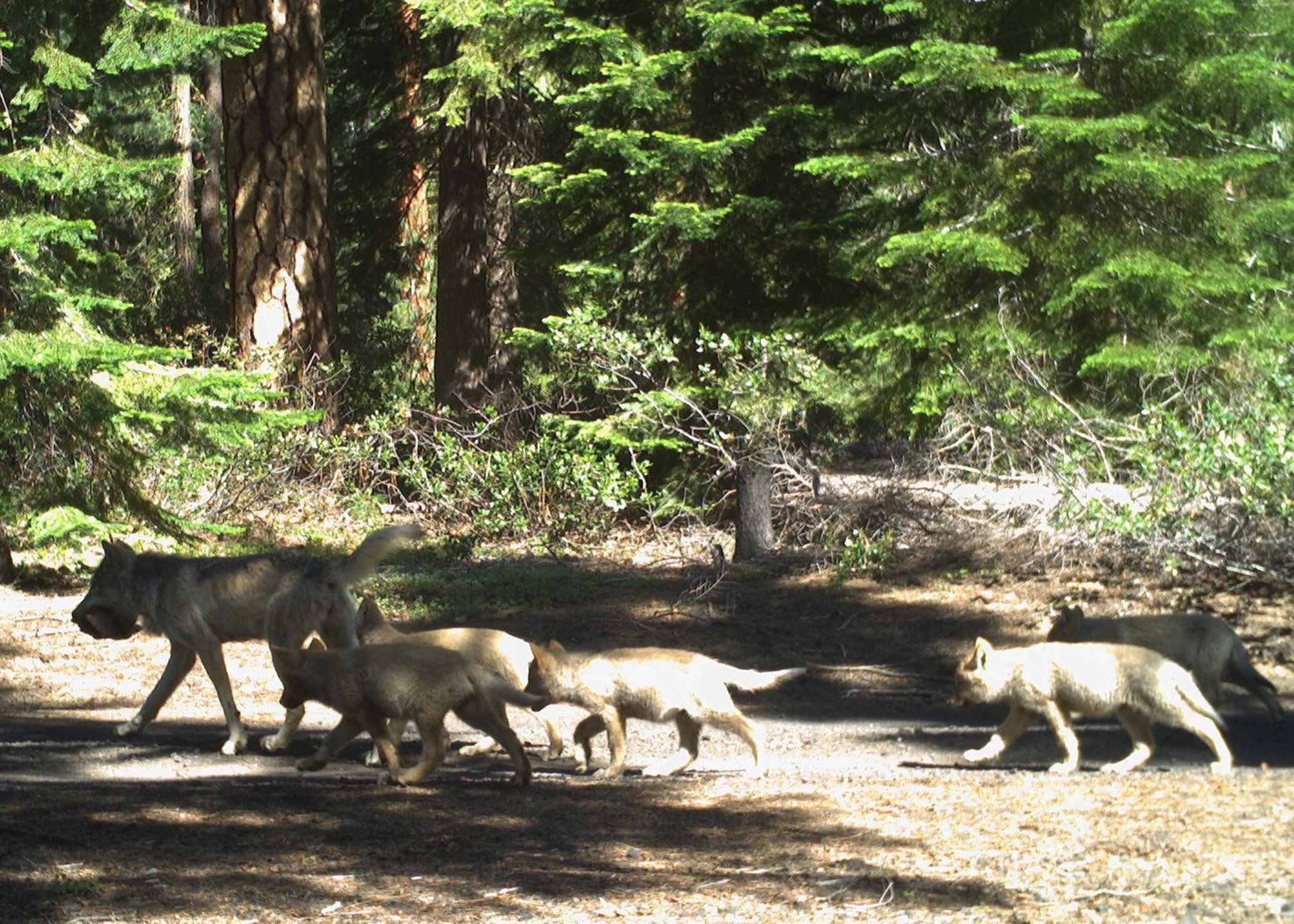Responsibly sharing our trails with returning gray wolves
By Story Warren
Upper Deschutes Pack pups (ODFW).
It’s a truly exciting time to be living in central Oregon, where rewilding is in progress, and people now have a chance of seeing or hearing a wild wolf here in Sisters Country. There are a lot of misconceptions about how wolves interact with humans, so now is a great time to consider wolf behavior and best practices for hiking and living alongside wolves.
Historically, wolves roamed across Oregon, but nationwide carnivore extermination campaigns led to the last one being killed in the state in the 1940s. Wolves began to naturally recolonize, migrating in from Idaho and Washington, around 2008. As of 2022, Oregon is home to 178 of them. Wolves in the western two-thirds of the state are listed as federally endangered.
I’ve been fortunate to spend a lot of time in wolf country, both for fun and for work. I’ve had the opportunity to work in several seasonal positions in Western states, including a field internship with the Oregon Department of Fish and Wildlife wolf program, helping to find new wolf packs, count and monitor existing packs, and place research collars on wolves. I have also been maintaining trail cameras in one wolf pack’s territory for nearly a decade, so I’ve had some amazing experiences in wolf country.
Should people be afraid of wolves?
The myth of the Big Bad Wolf is still alive and well. Wolves are often falsely portrayed as man-eaters, whether in Little Red Riding Hood or in recent movies like Frozen and The Grey. These scary representations can generate a lot of fear and uncertainty as wolves return to a landscape. So, do we need to be afraid of wolves?
In short – no.
Wolves tend to be very wary of humans and try to avoid us. Seeing a wolf can be a once-in-a-lifetime experience.
Wolf attacks on humans are extraordinarily rare. You’re more likely to get crushed by a vending machine than attacked by a wolf. There has not been a single documented wolf attack in any western state in the lower 48 since wolves were reintroduced to Idaho and Yellowstone in 1995, despite thousands of wolves and millions of people using the same landscapes for decades (since the 1990s, wolves have reestablished in Montana, Idaho, Wyoming, Oregon, Washington, and a small number in California). There have been just six wolf attacks on humans in North America in the past 20 years, two of them fatal. The incidents that have occurred in other parts of the continent often involved habituated wolves – animals who had lost their fear of humans through being fed by people or consistently finding food near campgrounds or dumps – or injured or emaciated wolves.
A recent report by John Linnell and others sums this up: “…the risks associated with a wolf attack are above zero, but far too low to calculate.”
So while we don’t need to be afraid of wolves, it’s important to learn about our wild neighbors, how we can respect their space, and how best to responsibly share our wild landscapes when hiking and enjoying nature.
Cold, snowy days at Jeff View Shelter, something to cherish.
While wolves are quite elusive, they also can utilize habitat close to people, including near trails, roads, and rural neighborhoods, just like cougars and bears sometimes do.
An ODFW video, featured in Central Oregon Daily, describes a typical wolf encounter. In places like Yellowstone where wolves are used to being in close proximity to people, or in the rare case that a wolf becomes habituated to people, they might behave differently. But this shows how most encounters here in the Pacific Northwest are likely to play out: https://centraloregondaily.com/wolf-encounter-odfw-intern-catches-incredible-video/?fbclid=IwAR23dSH2eHr1gfnqrSG5Gbq54OSbDm52mvP5lVwx-1HpCRRJByOeeYso6bc
The video, published by ODFW in 2019, remains relevant because year after year there are stories about wolves “surrounding” or “stalking” people, especially during hunting seasons when people are dressed in camo and imitating animal calls. Many wolves have been shot by people who felt threatened, not realizing that the wolf was likely oblivious to their presence, or the person had wandered close to pups (that scenario is explored below). In fact, an average of one wolf every year is shot in Washington alone by people “feeling threatened.” Fear is often people’s first response and that’s why learning about wolf behavior is so important.
In that 2019 video, the wolf didn’t see me (the intern) because the wind was blowing my scent away from the wolf, I was still, quiet, and obscured. If people stand up, shout, and wave, wolves will usually move the opposite direction when they realize there’s a scary human in the bushes.
As mentioned in the video, wolves don’t always run right away. Here are a few other behaviors you might observe.
Other possible behaviors…
- Alarm barking, bark-howling, howling repeatedly
o Indicates the wolf is nervous or feels threatened. You are probably too close.
- Escorting
o Following at a distance until you are out of the area that the wolves are protective of, such as a den, rendezvous, or feeding site.
These bolder behaviors are more likely if you are near a vulnerable location (like a den, rendezvous, or a carcass the family is feeding on), or if you have a dog with you, since wolves see dogs as intruders in their territory.
Vulnerable locations for wolf families - wolves may be more protective of these sensitive places:
Dens: where pups are born in the spring (usually April/May).
Rendezvous sites: safe places where pups grow up. They stay here while the adult family members leave to hunt and scavenge (pups are usually big enough to start traveling with the pack by September/October).
Feeding areas: carcasses of deer, elk, or moose that wolves are eating (any time of year).
If you see a lot of wolf tracks or scat in one place, you might be getting close to one of these vulnerable areas, so it’s best to leave the area so that you don’t stress and disrupt the wolf family. Wolves sometimes move their pups after human disturbance – imagine if someone walked through your living room!
Adult wolves can be protective of these places. If you observe behaviors like barking or escorting, it’s best to calmly leave the area, keeping dogs leashed, close, and under control.
Metolius wolf (ODFW).
Unfortunately, in 2018, an adult male wolf in northeastern Washington was shot in an act of self-defense by a man who “saw pups and heard barking and growling, and said he shot at the adult male as it barked and approached him.” The Washington Department of Fish and Wildlife, in a press release regarding the incident, said that “[v]ocalizations by wolves are not uncommon when people approach wolf pups, and adult wolves often attempt to escort perceived intruders away from areas where pups are present. While these behaviors are not necessarily predatory in nature, they can feel threatening.”
Again – a wolf barking or walking toward you, in all likelihood, is not a predatory behavior or a reason to shoot. They are probably communicating that you are too close. Wolf biologists, in the course of their job, sometimes have to walk through sensitive wolf locations, and aggressive behavior is virtually unheard of. Carrying bear spray is a responsible, non-lethal, and effective deterrent in the small chance you should need one. An air-horn can also be an effective way to scare off wolves without harming them.
Wolves, especially pups, can also be curious about people. If a wolf approaches you, it's best to discourage that behavior by acting loud and scary and then calmly leaving the area by backing away. A wolf that loses its fear of people is more likely to be shot, hit by a car, or other unsafe behavior.
And of course, never feed wildlife. A yearling male wolf, OR-143 from the Indigo Pack, was tragically killed by a vehicle strike on state Highway 138 in mid-June. This wolf seemed to have lost his wariness of people this spring – likely due to people feeding wolves from their vehicles. This is a tragic reminder that a fed wolf is a dead wolf.
Here are some basic do’s and don’ts for enjoying wolf country:
Do:
- Keep dogs leashed and under control. If you live in wolf country, it's best not to let your dogs out unsupervised, especially at night. It's well worth the safety of our pups and wildlife.
- Here is an excellent video on hiking safely with dogs in wolf country: https://www.spokesman.com/blogs/outdoors/2017/jul/27/video-hiking-safely-dogs-wolf-country/
- Be aware of your surroundings: pay attention to things like wind direction and the presence of animal tracks and sign.
- Follow “bear aware” steps for securing garbage and food around your home, campsites, and trailheads.
- Carry bear spray, keep it accessible on your person, and know how to use it correctly.
- Stay 100 yards away if you see a wolf.
Don't:
- Feed or approach wildlife.
- Seek out sensitive wolf locations.
From ODFW’s Wolf Human Interactions page:
“In the unlikely event that you encounter a wolf in the woods, here is what to do:
Stay calm. Make sure the wolf knows you are there. Talk in a loud firm voice or make loud noises and the wolf will likely run away.
If the wolf approaches or acts aggressively, wave your arms, yell and make yourself look larger. Use bear spray or air horns and throw any available objects. Pick up small children without bending down. If you can, group up with other people. Back away slowly to leave the area while facing the animal.
In the incredibly rare event that you are attacked by a wolf, fight back. Try to remain standing and use rocks, sticks, tools, camping gear and your hands to fend off the attack. Keep the animal away from your neck and head.”
Bear spray is designed to deter charging grizzly bears. Watch this 1-minute video from the National Park Service on how to properly deploy bear spray.
The take-home message is that it is incredibly exciting that wolves are returning to their native habitat here in central Oregon! Hiking in wolf country is an amazing and unique experience; count yourself quite lucky to even see a wolf or wolf tracks! Most often, all it takes is a shout to scare a wolf away who may be too close. Where there are wolves, there are also bears and cougars, and there are common sense steps – like leashing dogs, being aware of your surroundings, being familiar with animal behaviors, and carrying bear spray – that help us share our landscape with wildlife for generations to come.
Thanks to the The Wolf Welcome Committee (welcomewolf.org), in partnership with Story Warren, for this story. The WWC “envisions a time when wolves will be recovered in Central Oregon and our goal is to create a climate of peaceful co-existence where wolves are welcomed by their human neighbors. Through public education, we intend to enhance respect and appreciation for wolves by teaching about their highly developed pack social structure and extremely intelligent personalities. We will also affect policy changes by participating in County meetings with the goal of advocating for non-lethal protections of predators.” They collaborated with Story Warren to produce this informational blog.




